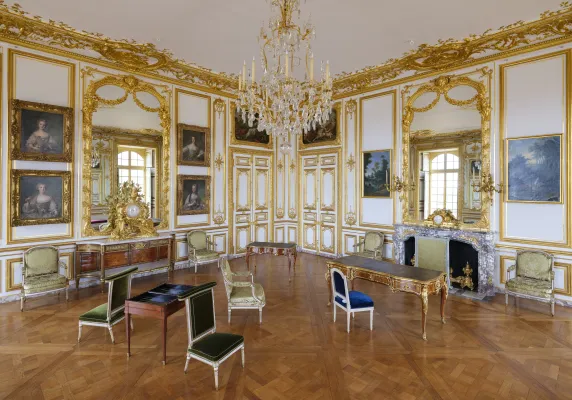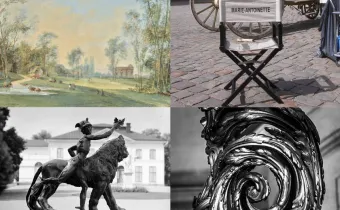Giving out onto the gardens on the ground floor of the palace’s main building, the Dauphin’s apartment is one of the former royal residence’s most prestigious, designed in a succession of rooms, each more opulent than the last. Now restored to its former glory, the apartment is an invitation to delve deep into the beating heart of the royal family’s private life. The three main rooms that form the Dauphin’s apartment — the bedchamber, the Great Chamber and library — were restored and offer up unique views of the gardens. They are positioned beneath the Hall of Mirrors, the Peace Room, and the Queen’s bedchamber respectively.
Yet between the 17th and 20th centuries, these spaces were used and tweaked in such a way as to gradually compromise the cohesiveness of the rooms and their décor. The restoration works returned the spaces to how they would have looked in the 1740s, when architect Ange-Jacques Gabriel was tasked with refurbishing the royal apartment occupied by Louis XV’s eldest son, the Dauphin Louis-Ferdinand.
The Dauphin’s Great Chamber
The Great Chamber is the corner room in the centre of the apartment. The décor here was entirely refreshed in 1747 with the help of sculptor Jacques Verberckt and his Rococo woodwork. Only the fireplace and a section of the sculpted panels have survived.
The room was subjected to its most significant alterations at the turn of the 19th century, when the Palace of Versailles was transformed into a museum on Louis-Philippe’s orders. It was at this point that most of the decorative elements were stripped away. In 1978, France’s programme law for museums paved the way for work to begin on restoring the Great Chamber to its Ancien Régime glory. This work had remained unfinished, and was finally completed through the campaign that was launched in October 2020.
The combination of period and more recent panelling did not reflect Gabriel’s original designs. The more structural elements such as the trumeau mirrors, the trumeaux between the windows and the large sculpted, gilded wooden panels had been missing, and were returned to the spaces during these restoration works, following in-depth assessment and research.
The Dauphin’s great chamber was restored thanks to the patronage of Baron Philippe de Rothschild S.A.
The Dauphin’s library
This small room is the cosiest in the apartment and lies adjacent to the Great Chamber. It was turned into a library between 1755 and 1756. It still bears most of its original layout and Rococo-style décor, with the emphasis on floral wreaths, dolphins and depictions of the arts (architecture and painting trophies, dancing putti).
This intimate space is a unique room, and an invaluable asset to the Palace of Versailles. Its colourful décor was carried out in 1756 in the ‘Vernis Martin’ style, a French lacquering technique, and embodies mid-18th-century tastes for painted interior design inspired by nature.
Restoration works in the library focused on the panelling, as assessments conducted on the painted decorative elements confirmed fears that the previous restoration works in the 1960s had been driven by misinterpretation, with the décor now looking yellowed and faded. The background was refreshed to restore the panels’ porcelain-look whites and blues. The stucco cornice appeared worryingly frail, and was both consolidated and repainted.
The Dauphin’s library was restored thanks to the patronage of the Société des Amis de Versailles, with the support of the Fondation du Patrimoine.
The Dauphin’s bedchamber
When the room was refurbished for the Dauphin, Louis XV’s son, in 1747, it was decorated by some of the greatest masters of the times. Jacques Verberckt sculpted the woodwork based on drawings by Ange-Jacques Gabriel, Jean-Baptiste Pierre produced the paintings above the doors (works of art that had been kept in the Palace of Versailles’ collections and were put back in place following the restoration), and Jacques Caffieri crafted the bronze sculptures.
The palace’s 19th-century refurbishment transformed the room, with much of the décor removed to ensure framed paintings could be mounted on the walls. In the 20th century, the woodwork and gilding was restored, the fireplace was dug out of the archives and returned to its rightful place, and the woodwork elements were put back up.
Today, the Dauphin’s bedchamber is one of the most opulent and best-preserved of the royal apartments, with much of its original décor still standing: a true masterpiece of Rococo art.
The restoration works polished the gilded panelling to a shine, returning a sense of splendour and sheen to the panels that had become dulled and flawed. The restoration works also set out to clean and add to the existing décor with the utmost respect shown for authenticity and the overall effect enhanced by repainting the walls in an immaculate, regal white.





